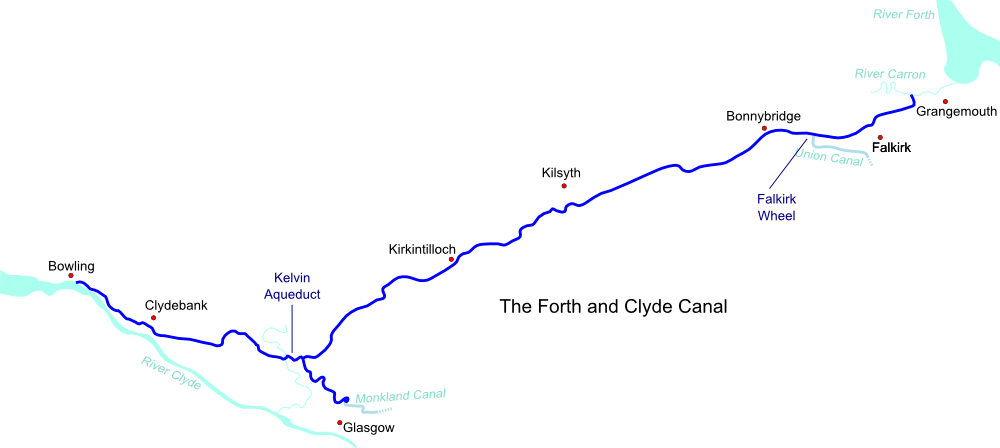

Map derived from data (c) OpenStreetMap
For detailed information on each section of the canal, click on the map
The first major canal to be built in Scotland, the Forth and Clyde was an ambitious project to build a coast-to-coast ship canal across central Scotland. After much arguing about what form it should take (Glasgow merchants favoured a smaller barge canal from the Forth to Glasgow, whereas most of the rest of Scotland wanted the more ambitious ship canal), construction began at Grangemouth on the Forth in 1768.
By 1790, the canal had been pushed right through to Bowling on the River Clyde, a distance of 35 miles, with a two mile branch into the centre of Glasgow. A series of twenty locks took the canal up from the Forth to its summit reach near Castlecary, and on the other side of the country nineteen locks descended from Maryhill to the Clyde. The canal also boasted what was at the time the largest aqueduct in Britain over the River Kelvin, and 38 wooden double-leaf opening bridges known as bascule bridges.
The canal quickly became a popular route. Fishing boats and yachts used it to cross from one side of Scotland to the other. Industries, from iron works to timber yards to boat builders to distilleries and more, sprang up along the banks. Villages and towns that were previously hard to get to, like Kirkintilloch, prospered as they took advantage of this new transport artery. The canal system was extended when the Monkland Canal connected to the Forth and Clyde at Port Dundas, Glasgow in 1791, and the Union Canal to Lock 16, Falkirk in 1822. Various smaller branch canals were built, including "short cuts" to the River Carron in the east and the Clyde in the west.
Passenger boats used the canal extensively too. Fast boats known as "Swifts" which ran all the way from Glasgow to Edinburgh using the Forth and Clyde and Union Canals were established. At the time they were far safer and more comfortable than the road-based alternatives. There were also much-loved pleasure steamers (the "Queens") that sailed out from Glasgow to a nice rural location at Craigmarloch.
But traffic declined severely in the late 19th and early 20th centuries, largely due to competition from first railways and then roads. Despite closure of the lock flight to the Union Canal in 1933, and of the Monkland Canal in 1952, the Forth and Clyde was maintained as a coast-to-coast route until the early 1960s. Then, when the A80 Glasgow to Stirling road was being upgraded to dual carriageway, it was deemed too costly to build a lifting bridge over the canal. Instead it was closed to navigation, and was quickly cut into sections by the new A80 and various other developments. Over a mile of canal was filled in at the Grangemouth end, and shorter sections were also filled in near Clobberhill and on the Glasgow branch. Many road bridges were replaced by culverts, and the remaining lock gates and opening bridges were fixed in position. Only a small section at Bowling was maintained in working order.
Thankfully, many people could see the potential for leisure and urban renewal that a restored canal could bring. They campaigned to save both the Forth and Clyde and Union canals from further damage and eventually to reopen them to boats. Pleasure craft began to return to the better preserved sections of the canal in the 1970s, although at this time there were still occasional road blockages being built. By the 80s, the restoration movement had gathered momentum - no more culverts or low bridges were built and some of the cut off sections were being reopened. Finally, thanks to a substantial grant from the National Lottery Millennium Fund, the canal was fully restored and reopened from sea to sea in May 2001. The following year, the Falkirk Wheel opened, reconnecting the Forth and Clyde to the Union Canal for the first time since 1933.
Although the canal is open again now, various further improvements have been made since 2001, or are still in progress. The original terminal basins at Port Dundas have been reconnected to the Glasgow branch of the canal with the construction of two new locks. And at the Grangemouth end, the Helix project is currently building a much improved link from the canal to the River Forth.